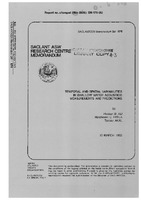| dc.contributor.author | Ali, Hassan B. | |
| dc.contributor.author | Ferla, Melchiorre C. | |
| dc.contributor.author | Akal, Tuncay | |
| dc.date.accessioned | 2018-10-11T14:05:49Z | |
| dc.date.available | 2018-10-11T14:05:49Z | |
| dc.date.issued | 1985/03 | |
| dc.identifier | 1656 | |
| dc.identifier.govdoc | SM-178 | |
| dc.identifier.uri | http://hdl.handle.net/20.500.12489/151 | |
| dc.description.abstract | An acoustic signal propagating in the sea is generally degraded not only by interactions with the bottom and surface boundaries, but also by volume inhomogeneities caused by non-uniformities in temperature, density, and salinity distributions. The degradations in the acoustical signal are manifested by fluctuations inits amplitude and phase and by an accompanying | |
| dc.description.abstract | loss in its coherence properties. The results of experiments conducted in a shallow water area of the Mediterranean are used to establish correlations between fluctuations in acoustic transmission loss and varia bility in the environmental parameters. The physical processes responsible for the observed fluctuations are identified primarily with inertial effects, semi-diurnal tides , and fine - structure. Using a modified version of SNAP (SACLANTCEN Normal Mode Acoustic Propagation Model) comparisons are made between measured and predicted acoustic transmission loss. | |
| dc.format | 10 p. : ill. ; 9 fig. | |
| dc.language | English | |
| dc.publisher | NATO. SACLANTCEN | |
| dc.relation.ispartofseries | A 156 718 | |
| dc.subject | Shallow water | |
| dc.subject | Modelling and environmental measurements | |
| dc.title | Temporal and spatial variabilities in shallow water acoustics: measurements and predictions | |
| dc.type | Scientific Memorandum (SM) | |
